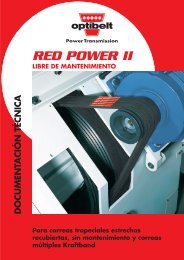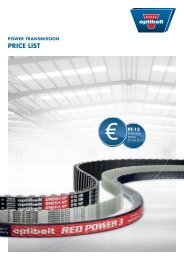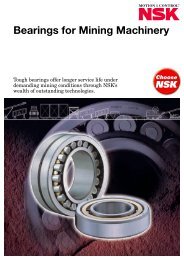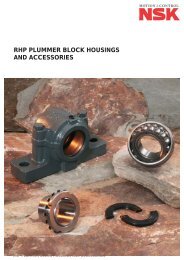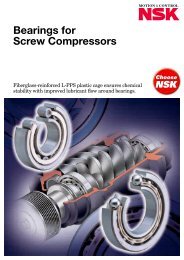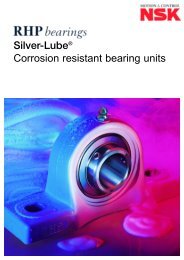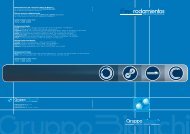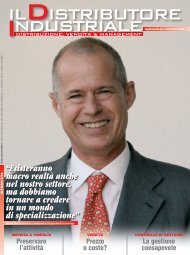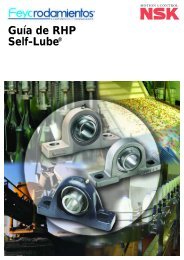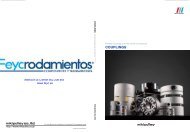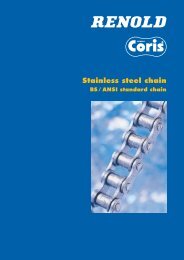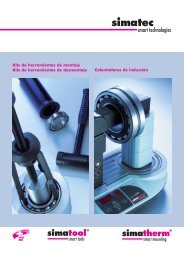- Page 1 and 2: Linear Units LINEAR UNITS www.Danah
- Page 3 and 4: Linear Units Table of Contents Tabl
- Page 5 and 6: Linear Units Introduction Introduct
- Page 7: Linear Units How to Choose Unit Bel
- Page 11 and 12: Linear Units Technical Introduction
- Page 13 and 14: Linear Units Ball Screw Drive and B
- Page 15 and 16: Linear Units Ball Screw Drive and B
- Page 17 and 18: Linear Units Ball Screw Drive and B
- Page 19 and 20: Linear Units Ball Screw Drive and B
- Page 21 and 22: Linear Units Ball Screw Drive and B
- Page 23 and 24: Linear Units Ball Screw Drive and B
- Page 25 and 26: Linear Units Ball Screw Drive and B
- Page 27 and 28: Linear Units Ball Screw Drive and B
- Page 29 and 30: Linear Units Ball Screw Drive and B
- Page 31 and 32: Linear Units Ball Screw Drive and B
- Page 33 and 34: Linear Units Ball Screw Drive and B
- Page 35 and 36: Linear Units Ball Screw Drive and B
- Page 37 and 38: Linear Units Ball Screw Drive and B
- Page 39 and 40: Linear Units Ball Screw Drive and B
- Page 41 and 42: Linear Units Ball Screw Drive and B
- Page 43 and 44: Linear Units Ball Screw Drive and B
- Page 45 and 46: Linear Units Ball Screw Drive and B
- Page 47 and 48: Linear Units Ball Screw Drive and S
- Page 49 and 50: Linear Units Ball Screw Drive and S
- Page 51 and 52: Linear Units Ball Screw Drive and S
- Page 53 and 54: Linear Units Ball Screw Drive and S
- Page 55 and 56: Linear Units Ball Screw Drive and S
- Page 57 and 58: Linear Units Ball Screw Drive and S
- Page 59 and 60:
Linear Units Ball Screw Drive and S
- Page 61 and 62:
Linear Units Ball Screw Drive and S
- Page 63 and 64:
Linear Units Belt Drive and Ball Gu
- Page 65 and 66:
Linear Units Belt Drive and Ball Gu
- Page 67 and 68:
Linear Units Belt Drive and Ball Gu
- Page 69 and 70:
Linear Units Belt Drive and Ball Gu
- Page 71 and 72:
Linear Units Belt Drive and Ball Gu
- Page 73 and 74:
Linear Units Belt Drive and Ball Gu
- Page 75 and 76:
Linear Units Belt Drive and Ball Gu
- Page 77 and 78:
Linear Units Belt Drive and Slide G
- Page 79 and 80:
Linear Units Belt Drive and Slide G
- Page 81 and 82:
Linear Units Belt Drive and Slide G
- Page 83 and 84:
Linear Units Belt Drive and Slide G
- Page 85 and 86:
Linear Units Belt Drive and Slide G
- Page 87 and 88:
Linear Units Belt Drive and Slide G
- Page 89 and 90:
Linear Units Belt Drive and Wheel G
- Page 91 and 92:
Linear Units Belt Drive and Wheel G
- Page 93 and 94:
Linear Units Belt Drive and Wheel G
- Page 95 and 96:
Linear Units Belt Drive and Wheel G
- Page 97 and 98:
Linear Units Belt Drive and Wheel G
- Page 99 and 100:
Linear Units Belt Drive and Wheel G
- Page 101 and 102:
Linear Units Belt Drive and Wheel G
- Page 103 and 104:
Linear Units Linear Lifting Units L
- Page 105 and 106:
Linear Units Linear Lifting Units M
- Page 107 and 108:
Linear Units Linear Lifting Units W
- Page 109 and 110:
Linear Units Linear Lifting Units W
- Page 111 and 112:
Linear Units Linear Lifting Units Z
- Page 113 and 114:
Linear Units Linear Lifting Units Z
- Page 115 and 116:
Linear Units Linear Lifting Units Z
- Page 117 and 118:
Linear Units Linear Rod Units Linea
- Page 119 and 120:
Linear Units Linear Rod Units Movot
- Page 121 and 122:
Linear Units Linear Rod Units WZ60
- Page 123 and 124:
Linear Units Linear Rod Units T90 B
- Page 125 and 126:
Linear Units Linear Rod Units T130
- Page 127 and 128:
Linear Units Accessories Accessorie
- Page 129 and 130:
Linear Units Accessories Accessorie
- Page 131 and 132:
Linear Units Accessories Accessorie
- Page 133 and 134:
Linear Units Accessories Accessorie
- Page 135 and 136:
Linear Units Accessories Accessorie
- Page 137 and 138:
Linear Units Accessories Accessorie
- Page 139 and 140:
Linear Units Accessories Accessorie
- Page 141 and 142:
Linear Units Accessories Accessorie
- Page 143 and 144:
Linear Units Accessories Accessorie
- Page 145 and 146:
Linear Units Accessories Accessorie
- Page 147 and 148:
Linear Units Accessories Accessorie
- Page 149 and 150:
Linear Units Accessories Accessorie
- Page 151 and 152:
Linear Units Accessories Accessorie
- Page 153 and 154:
Linear Units Accessories Motors, Ge
- Page 155 and 156:
Linear Units F G K L M P øT X Moto
- Page 157 and 158:
Linear Units Accessories Accessorie
- Page 159 and 160:
Linear Units Accessories Accessorie
- Page 161 and 162:
Linear Units Accessories Accessorie
- Page 163 and 164:
Linear Units Accessories Accessorie
- Page 165 and 166:
Linear Units Accessories Accessorie
- Page 167 and 168:
Linear Units Accessories Accessorie
- Page 169 and 170:
Linear Units Accessories Accessorie
- Page 171 and 172:
Linear Units Accessories Accessorie
- Page 173 and 174:
Linear Units Accessories Accessorie
- Page 175 and 176:
Linear Units Accessories Accessorie
- Page 177 and 178:
Linear Units Accessories Accessorie
- Page 179 and 180:
Linear Units Accessories Accessorie
- Page 181 and 182:
Linear Units Accessories Accessorie
- Page 183 and 184:
Linear Units Additional Technical D
- Page 185 and 186:
Linear Units Additional Technical D
- Page 187 and 188:
Linear Units Additional Technical D
- Page 189 and 190:
Linear Units Additional Technical D
- Page 191 and 192:
Linear Units Additional Technical D
- Page 193 and 194:
Linear Units Ordering Ordering How
- Page 195 and 196:
Linear Units Ordering Ordering Keys
- Page 197 and 198:
Linear Units Ordering Ordering Keys
- Page 199 and 200:
Linear Units Ordering Ordering Keys
- Page 201 and 202:
Linear Units Ordering Ordering Keys
- Page 203 and 204:
Linear Ordering Units Ordering Keys
- Page 205 and 206:
Linear Ordering Units Ordering Keys
- Page 207 and 208:
Linear Ordering Units Ordering Keys
- Page 209 and 210:
Linear Ordering Units Ordering Keys
- Page 211 and 212:
Linear Units 3



